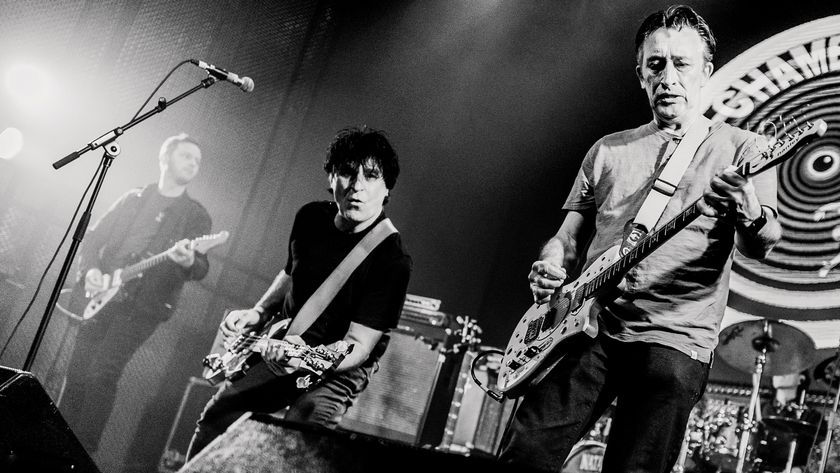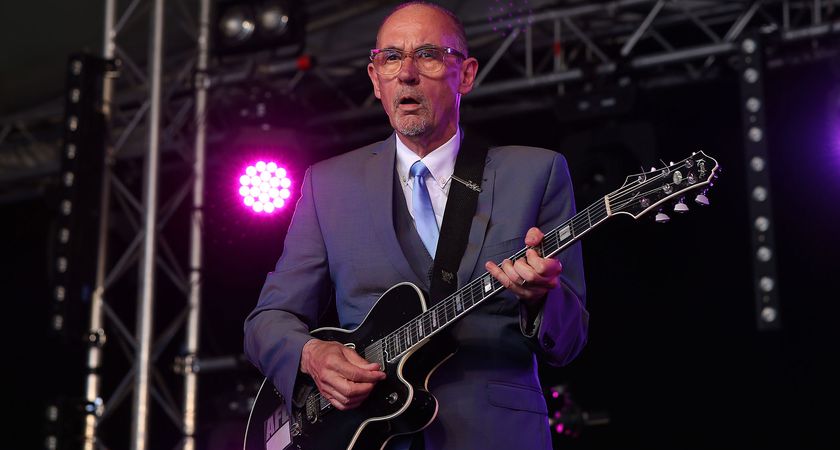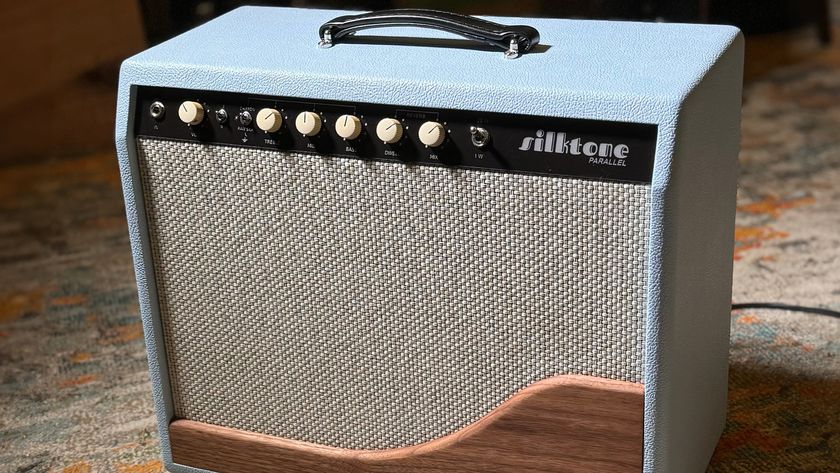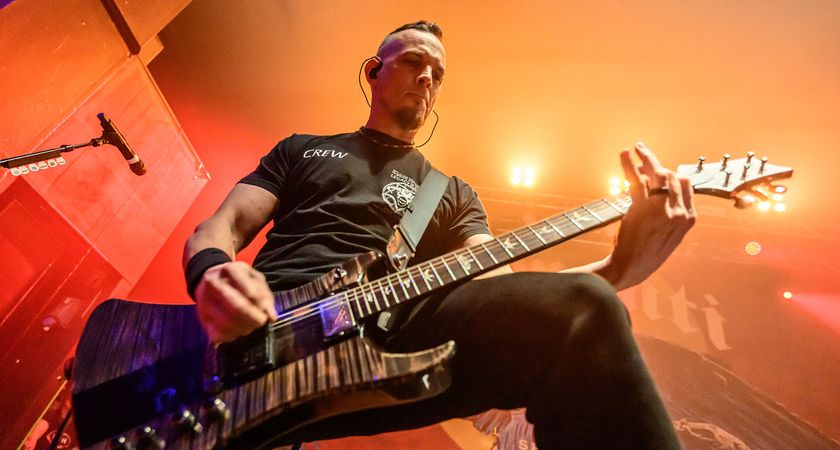Interview: Duane Denison Recalls The Jesus Lizard’s Glory Days of Creation and Demolition
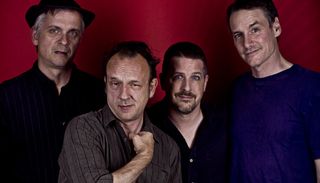
On July 14, 2009, at the Exit/In in Nashville, Tennessee, pioneer alt-noise band The Jesus Lizard made history.
After a 10-year breakup, the band played the first U.S. show of their long-awaited reunion tour. Before the gig, documentary filmmaker Matthew Robison volunteered the shoot the show no strings attached, and on August 23, Club will be released on DVD with MP3 downloads for each of the 22 tracks played that night.
For those unfamiliar with The Jesus Lizard, the Chicago-based band formed in 1987 when ex-Scratch Acid members David Yow (vocals) and David Wm. Sims (bass) hooked up with guitarist Duane Denison and the three started writing offbeat, angular songs that incorporated elements of hardcore, art-rock, blues and jazz.
The band’s first EP, 1989’s Pure, was written with a drum machine. The next year, they recruited precise, but freewheeling drummer Mac McNeilly and started to turn heads with their 1990 full-length debut Head. Over the next decade, the band put out five more full-length albums, a live disc and two more EPs before breaking up.
The decision to reunite came after their former label, Touch & Go, decided to re-master and re-release four of The Jesus Lizard’s records with bonus tracks. After receiving rave reviews at a series of festivals in Europe, The Jesus Lizard planned their U.S. reunion tour.
Guitar World recently talked to Denison about the Club DVD, the distinctive guitar sound and style of The Jesus Lizard, the group’s rocky history, his distain for the Metallica movie Some Kind of Monster, the other groups he’s in and the future of The Jesus Lizard, a band that, for a decade at least, made volatility and danger an everyday event.
GUITAR WORLD: The Jesus Lizard reunion shows were amazing. How did the DVD come together? And is it just a live show or a documentary?
Get The Pick Newsletter
All the latest guitar news, interviews, lessons, reviews, deals and more, direct to your inbox!
Matthew Robison. He’s done some documentary stuff and was a fan of the band. He was at the show. He contacted me and asked if he could bring a camera crew and a sound crew, and he said we had no obligation. If we didn’t like how it turned out, we could give him the word and that would be that. So how could we go wrong? It turned out that it was a good show. So he found a distributor and everything fell into place.
What was the highlight of the evening?
It was the first U.S. show. We had played overseas at All Tomorrow’s Parties. So really, right from the get-go, there was a lot of energy. I think we opened with “Puss,” which has always been one of my favorites. And seeing the crowd go off right from the beginning was really good. Also, a lot of people wouldn’t think of The Jesus Lizard as a sing-along band. Well, there was no shortage of people that knew every bit of every song. So that was enjoyable, too.
Toward the end of the band’s run, we signed with Capitol and that seemed to alienate people, some of whom never even heard those albums. And we played a few songs from those as well, and they went over just fine. So that was gratifying on a number of levels.
Were you happy with the records you did for Capitol? Did they pressure you write more commercial songs?
No, it wasn’t anything like that. Half of the people who bought the previous album on Touch & Go, Down, didn’t buy Shot, and Shot was a better album. It sounded better, the songs were better. In retrospect, that’s how people were. I don’t know if they’re still like that.
Does the DVD also have a documentary element to it?No, it’s just the show. We tried throwing some skits in there, but it didn’t work. We were trying to mock the Metallica documentary Some Kind of Monster, where they have their therapist with them walking them around. I just thought that was embarrassing and truly awful and an excessive, infantile presentation. There was a child psychologist who lived down the street from me and he was a Jesus Lizard fan. So he was pretending to council us and we were going along in a mock way. We did a couple of them and they just weren’t funny. It just didn’t work. They’ve been deleted and will disappear.Jesus Lizard were considered a noise rock band, but dissonance was only a part of your sound. You brought an angular guitar style to the group, had a keen sense of building and releasing rhythmic tension and incorporated elements of jazz and blues that many of your peers lacked. How did you apply those elements to the music and make it work?It was never arbitrary. If there was dissonance, it was usually built into the chords themselves. Harmonically there was still a pretty close relation to the tonal structure of the songs, as usually laid down by the bass –- at least the foundation of it. There was not too much that was random about my playing. I always knew what I was doing. My brother-in-law used to say, “You always played the wrong notes.” Well, no, they’re not wrong, they’re all completely intentional. Even though we were part of the hardcore scene, at the same time I always thought it was more like art rock played more aggressively and in more of a stripped-down manner. When I think of hardcore, I think of Cro-Mags or Agnostic Front, where it’s driven by straight-up power chords and usually the bass and guitar are playing the same thing and a singer yells aggressively over the top. Sure, there are times when only a power chord will do, but we wanted to do things that weren’t so obvious and ham-fisted. We wanted to avoid clichés, at least most of the time. At the same time, we didn’t want to get too clever with it or too artsy with it, or it stops being rock and stop having that visceral experience.Did you have a background in jazz or blues guitar?I have a degree in music. I studied music in college, so I had that. Like most guys who play electric guitar, you probably start out by playing blues and blues rock. I played in bands that started off doing school dances. At least when I was a kid, you had to learn those styles so you could play those three-set gigs where people just wanted to dance. I grew up in a suburb of Detroit called Plymouth, and there was a number of professional guitar players who all lived within a stone’s throw of me. I took a few lessons from a fellow named Paul Warren, who, as a very young man, played with the Temptations. He was on the song “Papa Was a Rolling Stone.” Did you feel a kinship with bands like Tar, Surgery, Godbullies, The Cows and other so-called noise rock bands of the early ‘90s?Yes, in the sense that we were from a similar geographic area and we were on independent labels. But we came from a different place. We were in the underground scene but we were all very artsy and liked older things that had nothing to do with the underground, and we weren’t afraid to referencing those things. Whereas a lot of bands from that era would never own up to liking Led Zeppelin or admit they owned a Brand X album. And we more than happy to do that and reference it in the music itself. People sometimes pretend there was a kinship, but deep down everyone was very competitive and when their band takes the stage, they want to have the big crowd, they want the biggest reaction, they want to move up the food chain.How did you get the bright, cutting tones you used with The Jesus Lizard?The set-up I used for the longest time, which became the signature time, was a Travis Bean Artist guitar with the aluminum neck plugged straight into a Hiwatt DR103 100 watt head and a Hiwatt 4 X 12. And that gave me a very bright, sharp, well-defined sound. It’s funny because after Jesus Lizard broke up, I sold those guitars and when we decided to get back together I worked with a company in Florida called The Electrical Guitar Company, and they make all-aluminum guitars. So he approached me. And on that live DVD, the white guitar I’m playing is an all-aluminum custom model by Electrical.Jesus Lizard didn’t play with the high levels of distortion that other bands used. Did you roll back the tone knob or use a certain pickup select to give you that brightness?No, that’s pretty much how those amps sound. Those old Hiwatts don’t have the saturation or really compressed overdrive that other amps have and that people in that genre typically use. So the amount of distortion I used was fairly minimal compared to other bands, which once again was intentional. If you’re playing chords other than power chords, to me, the thicker the distortion, the worse they sound. It just turns into a mud cloud. And I wanted to bring out and be able to hear individual notes. I played a lot of arpeggios and patterns that had detail to them. And I wanted those to be heard.Is Jesus Lizard vocalist David Yow as unstable and insane as everyone thinks?I don’t think he’s insane in the clinical sense. Obviously, during performances he would go off. And a lot of that was just alcohol and whatever else was around. Like most artistic people, he had a different filter on the world. There was nothing contrived or calculated about it to be a marketable concept. And he’s actually a very gracious person. There’s always gonna be a flip side where he becomes overbearing and obnoxious and does thoughtless things.Did you guys always get along?No! I mean, when you have a band like that and you spend that much time together, you’re spending more time together than most families do. When we started that band we all lived in a threebedroom apartment in a Puerto Rican ghetto on the west side of Chicago. We were around each other 24-7 and then we’d go home and we were still around each other. So we had arguments and disagreements, and sometimes they got a little violent. We’d be furious with each other, but we realized we had to work again with each other tomorrow. We couldn’t just walk away from it. It wasn’t a reality show. We didn’t talk about our feelings. We were direct and confrontational and I think that worked.What was the biggest flare-up? Did you ever have fisticuffs and did things ever go flying across the room?Sure. Punches, shoving. Lamps and other objects thrown. I don’t remember them all. Usually it was something someone did that was really stupid. And it would set someone off: “Why did you fucking do that!?” “Why don’t you just shut up!? Why do you always have to …” – that kind of thing. Take four guys and put them in a room, add alcohol and stir craziness and eventually you’re gonna go off. We just learned how to deal with it.Was there a particular incident that led to the band’s decision to break up?No. By that time we had been together for 10 years and we had worked our way up, enjoyed a nice plateau and it seemed like things were starting to work their way back down. We could have ridden it out a little while longer, but we just didn’t want to. Like, why? We did it. We said everything we wanted to say and did what we wanted to do, so the decision to give it up was pretty amicable and mutual.Why did you decide to do the reunion tour?Touch & Go were talking about re-mastering and reissuing the back catalog. That coincided with fact that it would have been 10 years since we broke up and 20 years from the time we started. It just seemed like everything was falling into place. We were all in pretty good health and had been playing. I have a practice space in Nashville that was centrally located for everyone. And the offers [from promoters] were seriously good. So it all seemed to fall into place and add up and we said, “Look, if we’re ever going to do this, we should do it now.” And we’d been getting offers all along, but to me, if you’re a band of any note, you can’t do a reunion tour after five years; you haven’t been broken up long enough. That’s not a reunion, it’s a continuance. Ten years is a good amount. The tour was amazing, as the DVD attests. Did that inspire you guys to wrote more songs together and play more tours?No. We wanted to avoid that cliché as well. We didn’t want to do the endless reunion tour. Are you still active with Tomahawk?Yes. I have about a full album’s worth of instrumental demos that have been circulating and I just got an email from Mike Patton (Faith No More, Fantomas) today. And we’re talking all the time. And I’ve been talking with John Stanier (ex-Helmet) and Trevor Dunn (ex-Mr. Bungle, Fantomas). And we will most likely be recording a new album in January.You worked with ex-Ministry bassist Paul Barker in the band U.S.S.A. in 2007. Will there be a second album released?I don’t think so. There’s a second album that we did and it just got held up. The company we were working with went out of business. All the labels seemed to crash around that time. When you’re doing a group that’s spread out across the country, if you’re not making money it’s hard to keep it going. I liked the record we did together and I felt it was overlooked. There were a number of songs on there that came out exactly as we wanted them to, and just seemed to get thrown into the ocean. It disappeared. It came out and did nothing. We toured. And I got a hernia on that tour. I spent the last two weeks hobbling around, so it was an all around miserable experience?How did you get the hernia?I was lifting a 4X12 cabinet up a very steep flight of stairs. I had done it literally thousands of times, but this one time I was twisted at an odd angle. An hour later I was walking in an alley behind this club and it just didn’t feel right.Is your new band rockabilly/Dixieland punk band The Legendary Shack Shakers a big priority for you?Yeah, it has been for about three years. I put a lot of time into it touring and there’s a pretty good amount of me on their last album, Aggridustrial. They took time off to let me do that reunion tours, but we still played about 100 shows last year. And we’ll be doing some more U.S. touring in the fall. I really enjoy playing with them. Part of the time, it’s more traditional. I play more bluesy riffs and more vintage sound like slapback, tremolo, heavy reverb, slide guitar. And on some of the recent stuff, we did more sonic things with non-traditional weird noises, so I do a fair amount of that with them as well.
Jon is an author, journalist, and podcaster who recently wrote and hosted the first 12-episode season of the acclaimed Backstaged: The Devil in Metal, an exclusive from Diversion Podcasts/iHeart. He is also the primary author of the popular Louder Than Hell: The Definitive Oral History of Metal and the sole author of Raising Hell: Backstage Tales From the Lives of Metal Legends. In addition, he co-wrote I'm the Man: The Story of That Guy From Anthrax (with Scott Ian), Ministry: The Lost Gospels According to Al Jourgensen (with Al Jourgensen), and My Riot: Agnostic Front, Grit, Guts & Glory (with Roger Miret). Wiederhorn has worked on staff as an associate editor for Rolling Stone, Executive Editor of Guitar Magazine, and senior writer for MTV News. His work has also appeared in Spin, Entertainment Weekly, Yahoo.com, Revolver, Inked, Loudwire.com and other publications and websites.
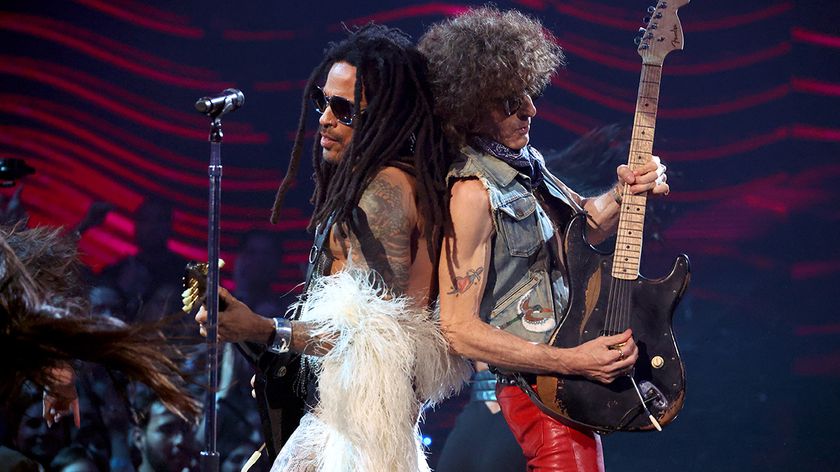
“We had 15 minutes left, and it was time to go… I just started playing that riff. Then Lenny goes, ‘Whoa, what’s that?’” Lenny Kravitz guitarist Craig Ross reveals the serendipitous roots of a Kravitz classic

“The concept of the guitar duel at the end was just appalling”: Crossroads is an essential piece of '80s guitar lore, but not every guitar legend was a fan of the film






